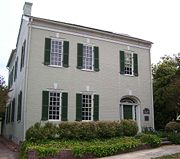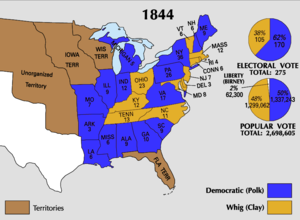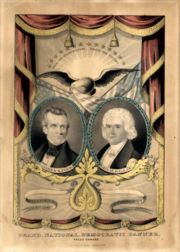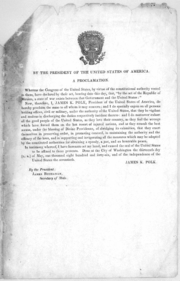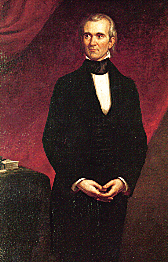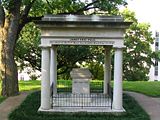James K. Polk
2008/9 Schools Wikipedia Selection. Related subjects: USA Presidents
|
James Knox Polk
|
|
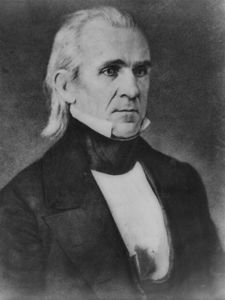 Daguerreotype of President Polk, taken by Matthew Brady or John Plumbe |
|
|
|
|
|---|---|
| In office March 4, 1845 – March 4, 1849 |
|
| Vice President | George M. Dallas (1845-1849) |
| Preceded by | John Tyler |
| Succeeded by | Zachary Taylor |
|
11th Governor of Tennessee
|
|
| In office October 14, 1839 – October 15, 1841 |
|
| Preceded by | Newton Cannon |
| Succeeded by | James Chamberlain Jones |
|
|
|
| In office December 7, 1835 – March 4, 1839 |
|
| President | Andrew Jackson Martin Van Buren |
| Preceded by | John Bell |
| Succeeded by | Robert M. T. Hunter |
|
Member of the U.S. House of Representatives
from Tennessee's 6th district |
|
| In office March 4, 1825 – March 3, 1833 |
|
| Preceded by | John A. Cocke |
| Succeeded by | Balie Peyton |
|
Member of the U.S. House of Representatives
from Tennessee's 9th district |
|
| In office March 4, 1833 – March 3, 1839 |
|
| Preceded by | William Fitzgerald |
| Succeeded by | Harvey M. Watterson |
|
|
|
| Born | November 2, 1795 Pineville, North Carolina |
| Died | June 15, 1849 (aged 53) Nashville, Tennessee |
| Nationality | American (US) |
| Political party | Democratic |
| Spouse | Sarah Childress Polk |
| Alma mater | University of North Carolina at Chapel Hill |
| Occupation | Lawyer, Farmer ( Planter) |
| Religion | Methodist |
| Signature | |
James Knox Polk (pronounced /ˈpoʊk/ or /ˈpoːlk/; November 2, 1795 – June 15, 1849) was the eleventh President of the United States, serving from March 4, 1845 to March 4, 1849. Polk was born in Mecklenburg County, North Carolina, but mostly lived in and represented the state of Tennessee. A Democrat, Polk served as Speaker of the House (1835–1839) and Governor of Tennessee (1839–1841) prior to becoming president.
A firm supporter of Andrew Jackson, Polk was the last "strong" pre-American Civil War president. Polk is noted for his foreign policy successes. He threatened war with Britain then backed away and split the ownership of the Northwest with Britain. He is even more famous for leading the successful Mexican–American War. He lowered the tariff and established a treasury system that lasted until 1913. A " dark horse" candidate in 1844, he was the first president who retired after one term and did not seek re-election. He died of cholera three months after his term ended.
As a Democrat committed to geographic expansion (or "Manifest Destiny"), he overrode Whig objections and was responsible for the second-largest expansion of the nation's territory. Polk secured the Oregon Territory (including Washington, Oregon and Idaho), amounting to about 285,000 square miles (738,000 km²) then purchased 525,000 square miles (1,360,000 km²) through the Treaty of Guadalupe Hidalgo that ended the Mexican–American War.
The expansion re-opened a furious debate over allowing slavery in the new territories. The controversy was inadequately arbitrated by the Compromise of 1850, and only found its ultimate resolution on the battlefields of the U. S. Civil War. Polk signed the Walker Tariff that brought an era of near free trade to the country until 1861. He oversaw the opening of the U.S. Naval Academy and the Smithsonian, the groundbreaking for the Washington Monument, and the issuance of the first postage stamps in the United States, introduced by his Postmaster General Cave Johnson. He was the first President of the United States to be photographed frequently while in office. Scholars have ranked him 8th to 12th on the list of greatest presidents for his ability to set an agenda and achieve all of it.
Early life
Polk, the first of ten children, was born in a log farmhouse in what is now Pineville, North Carolina in Mecklenburg County on November 2, 1795, just outside of Charlotte. His father, Samuel Polk, was a slaveholder, successful farmer and surveyor of Scots-Irish descent. His mother, Jane Polk (née Knox), was a descendant of a brother of the Scottish religious reformer John Knox and named her firstborn after her father James Knox. While Jane was a Presbyterian, Samuel's father was a deist, so when James was taken to be baptized, Samuel had a religious argument with the minister and refused to have his son baptized. In 1803, the majority of Polk's relatives moved to the Duck River area in what is now Maury County, Middle Tennessee; however, Polk's family waited until 1806 to follow. The family grew prosperous, with Samuel Polk becoming one of the leading planters of the area as well as a county judge.
During his childhood, James suffered from poor health, which additionally negatively affected his early schooling. In 1812, just before he turned 17, his father tried to take him to Philadelphia to seek Dr. Philip Syng Physick in the back of a covered wagon. However, his pain became so unbearable that he was taken instead to the nearer Dr. Ephraim McDowell of Danville, Kentucky, who conducted an operation to remove urinary stones. The operation may have left James sterile, as Polk never had children.
When Polk recovered, his formal education began at the age of 18, when he studied at the Zion Church near his home. He later attended an academy in Murfreesboro, where he potentially could have met his future wife, Sarah Childress; however, this has not been convincingly proven. In 1815, a younger brother, William Hawkins Polk, was born; William eventually served as charge d'affairs to the Kingdom of the Two Sicilies during the Polk administration and later as a U.S. Congressman. James was then admitted to the University of North Carolina as a second-semester sophomore. The Polks had connections with the university, then a small school of about eighty students: Sam Polk was their land agent for Tennessee, and his cousin, William Polk, was a trustee. While there, Polk joined the Dialectic Society, in which he learned the art of oration. He also became the first person to be reelected president of the society. Among the people Polk met at the university was his roommate William Dunn Moseley, who later became the first governor of Florida. Polk graduated in May 1818 at the top of his class.
After graduation, Polk travelled to Nashville to study law under renowned Nashville trial attorney Felix Grundy. While working for Grundy, he served as clerk of the Tennessee State Senate from 1819 to 1822, a position which enabled him to learn the routine of the legislature. Polk was admitted to the bar in June 1820, and established his own practice in Columbia, Tennessee while the Senate was in recess. His first case was to defend his father against a public fighting charge, a case which he won. He worked with Aaron V. Brown, future Governor of Tennessee and Postmaster General.
Political career
Polk was brought up as a Jeffersonian Democrat, for his father and grandfather were strong supporters of Thomas Jefferson. The first public office he held was that of chief clerk of the Senate of Tennessee (1819–1822). He resigned the position in order to run his successful campaign for the state legislature in 1822, in which he defeated an incumbent. Polk's oratory became popular, earning him the nickname "Napoleon of the Stump."
He courted Sarah Childress, and they married on January 1, 1824. Polk was then 28, and Childress was 20 years old. Through their marriage, they had no children. They were married until his death in 1849. During Polk's political career, Sarah was said to assist her husband with his speeches, give him advice on policy matters and was always active in his campaigns. An old story told that Andrew Jackson had encouraged their romance when they began to court.
Polk became a supporter of Andrew Jackson, then the leading politician of Tennessee. In 1824, Jackson ran for President, while Polk campaigned for the House of Representatives. Polk succeeded at age twenty-nine, but Jackson was defeated. Though Jackson had won the popular vote, neither he nor any of the other candidates ( John Quincy Adams, Henry Clay, and William H. Crawford) had obtained a majority of the electoral vote. The House of Representatives then had to select the victor. In his first speech, Polk expressed his belief that the House's decision to choose Adams was a violation of the will of the people. He even proposed, unsuccessfully, that the Electoral College be abolished.
In Congress, Polk was a firm supporter of Jacksonian democracy. He opposed the Second Bank of the United States, favored gold and silver over paper money, distrusted banks, and preferred agricultural interests over industrial ones. This behaviour earned him the nickname "Young Hickory," an allusion to Andrew Jackson's sobriquet, "Old Hickory." After Jackson defeated Adams in the presidential election of 1828, Polk rose in prominence. He became leader of the pro-Administration faction in Congress. As chairman of the powerful Ways and Means Committee, he was a chief lieutenant to President Jackson to abolish the National Bank.
Speaker of the House
In December 1835, Polk defeated John Bell for the Speakership of the House, which he held for four years, during the Twenty-fourth and Twenty-fifth Congresses. Jackson left office two years later, to be succeeded by fellow Democrat Martin Van Buren. Polk led a splintered House of Representatives: there was one vote difference between the Democrats and the Whigs when he was chosen; there were several third-party Representatives, and the Democrats and Whigs were themselves divided into factions.
Polk worked for Jackson's policies as speaker, and Van Buren's when he succeeded; he appointed committees with Democratic Chairmen and majorities, including the New York radical C. C. Cambreleng as Chairman of the Ways and Means Committee, although he maintained the facade of traditional bipartisanship. Economic issues were the chief business of the House in his time, which included the Panic of 1837; Polk prevented the repeal of the anti-inflationary Specie Circular, and attempted, but failed, to pass the Independent Treasury plan, by which the Treasury would itself hold the revenues of the United States, instead of lending them to a private Bank or Banks as operating capital.
Polk attempted to make a more orderly House; he maintained the gag rule against abolitionist petitions against slavery, and he himself steadily declined to react to Whig personal attacks by dueling, as was still customary.
Governor of Tennessee
In 1838, the political situation in Tennessee—where, in 1835, Democrats had lost the governorship for the first time in their party's history—convinced Polk to return to help the party at home. Leaving Congress in 1839, Polk became a candidate in the Tennessee gubernatorial election, defeating the incumbent Whig, Newton Cannon by about 2,500 votes, out of about 105,000. Though he revitalized Democrats in Tennessee, his victory could not put a stop to the political decline of the Democratic Party elsewhere in the nation.
In the presidential election of 1840, Van Buren was overwhelmingly defeated by a popular Whig, William Henry Harrison. Polk received one electoral vote from Tennessee for Vice President in the election. Polk lost his own gubernatorial re-election bid to a Whig, James C. Jones, in 1841, by a slightly greater margin. He challenged Jones in 1843 but was defeated once again. Throughout all three of these campaigns, he focused on the policy differences on the economy between the Whigs and the Democrats. He attacked the Whig platform on economic policies during these campaigns. These three campaigns of attacking the Whigs chiefly helped him gain a national spotlight within the Democratic Party, which helped him win the nomination for president in 1844.
Election of 1844
Polk initially hoped to be nominated for vice-president at the Democratic convention, which began on May 27, 1844. The leading contender for the presidential nomination was former President Martin Van Buren, who wanted to stop the expansion of slavery. Other candidates included James Buchanan, General Lewis Cass, Cave Johnson, John C. Calhoun, and Levi Woodbury. The primary point of political contention involved the Republic of Texas, which, after declaring independence from Mexico in 1836, had asked to join the United States. Van Buren opposed the annexation but in doing so lost the support of many Democrats, including former President Andrew Jackson, who still had much influence. Van Buren won a simple majority on the convention's first ballot but did not attain the two-thirds supermajority required for nomination. After six more ballots, when it became clear that Van Buren would not win the required majority, Polk was put forth as a " dark horse" candidate. The eighth ballot was also indecisive, but on the ninth, the convention unanimously nominated Polk, supported by Jackson.
Prior to the convention, Polk was called to the home of Andrew Jackson, by Jackson himself. Jackson told Polk that he was his favorite for the nomination of the Democratic Party. Even with this support, Polk still instructed his managers at the convention to support Van Buren, but only if it was certain that Van Buren had a chance to win the nomination. This assured that if a deadlock convention occurred, initial supporters of Van Buren would pick Polk as a compromise candidate for the Democrats. In the end, this is exactly what happened as a result for Polk's support of westward expansion.
When advised of his nomination, Polk replied: "It has been well observed that the office of President of the United States should neither be sought nor declined. I have never sought it, nor should I feel at liberty to decline it, if conferred upon me by the voluntary suffrages of my fellow citizens." Because the Democratic Party was splintered into bitter factions, Polk promised to serve only one term if elected, hoping that his disappointed rival Democrats would unite behind him with the knowledge that another candidate would be chosen in four years.
Polk's Whig opponent in the 1844 presidential election was Henry Clay of Kentucky. (Incumbent Whig President John Tyler—a former Democrat—had become estranged from the Whigs and was not nominated for a second term.) The question of the annexation of Texas, which was at the forefront during the Democratic Convention, once again dominated the campaign. Polk was a strong proponent of immediate annexation, while Clay seemed more equivocal and vacillating.
Another campaign issue, also related to westward expansion, involved the Oregon Country, then under the joint occupation of the United States and Great Britain. The Democrats had championed the cause of expansion, informally linking the controversial Texas annexation issue with a claim to the entire Oregon Country, thus appealing to both Northern and Southern expansionists. (The slogan "Fifty-Four Forty or Fight", often incorrectly attributed to the 1844 election, did not appear until later; see Oregon boundary dispute.) Polk's consistent support for westward expansion—what Democrats would later call "Manifest Destiny"—likely played an important role in his victory, as opponent Henry Clay hedged his position.
In the election, Polk and his running mate, George M. Dallas, won in the South and West, while Clay drew support in the Northeast. Polk lost his home state of Tennessee as well as North Carolina, his alma mater. However, Polk won the crucial state of New York (with the support of many Van Buren supporters, since it was his home state), where Clay lost supporters to the third-party candidate James G. Birney of the Liberty Party, who was anti-slavery. Also contributing to Polk's victory was the support of new immigrant voters, who were angered at the Whigs' policies. Polk won the popular vote by a margin of about 39,000 out of 2.6 million, and took the Electoral College with 170 votes to Clay's 105. Polk won 15 states, while Clay won 11.
Polk is still the only Speaker of the House of Representatives ever to be elected President of the United States.
Presidency
When he took office on March 4, 1845, Polk, at 49, became the youngest man at the time to assume the presidency. According to a story told decades later by George Bancroft, Polk set four clearly defined goals for his administration:
- The re-establishment of the Independent Treasury System.
- The reduction of tariffs.
- Acquisition of some or all of the Oregon Country.
- The purchase of California from Mexico.
Pledged to serve only one term, he accomplished all these objectives in just four years. By linking acquisition of new lands in Oregon (with no slavery) and Texas (with slavery), he hoped to satisfy both North and South. During his presidency James K. Polk was known as "Young Hickory" and "The Napoleon of the Stump" for his speaking skills.
Fiscal policy
In 1846, Congress approved the Walker Tariff (named after Robert J. Walker, the Secretary of the Treasury), which represented a substantial reduction of the high Whig-backed Tariff of 1842. The new law abandoned ad valorem tariffs; instead, rates were made independent of the monetary value of the product. Polk's actions were popular in the South and West; however, they earned him the enmity of many protectionists in Pennsylvania.
In 1846, Polk approved a law restoring the Independent Treasury System, under which government funds were held in the Treasury rather than in banks or other financial institutions. This established independent treasury deposit offices, separate from private or state banks, to receive all government funds.
Slavery
Polk's views on slavery made his presidency bitterly unpopular between proponents of slavery, opponents of slavery, and advocates of compromise. During his presidency, many abolitionists harshly criticized him as an instrument of the " Slave Power," and claimed that the expansion of slavery lay behind his support for the annexation of Texas and later war with Mexico. Polk stated in his diary that he believed slavery could not exist in the territories won from Mexico, but refused to endorse the Wilmot Proviso that would forbid it there. Polk argued instead for extending the Missouri Compromise line to the Pacific Ocean, which would prohibit the expansion of slavery above 36° 30' west of Missouri, but allow it below that line if approved by eligible voters in the territory. William Dusinberre has argued that his diary, which he kept during his presidency, was written for later publication, and does not represent Polk's real policy; most historians accept it.
Polk was a slaveholder for his entire life. His father, Samuel Polk, had left Polk more than 8,000 acres (32 km²) of land, and divided about 53 slaves to his widow and children after Samuel died. James inherited twenty of his father's slaves, either directly or from deceased brothers. In 1831, he became an absentee cotton planter, sending slaves to clear plantation land that his father had left him near Somerville, Tennessee. Forty years later Polk sold his Somerville plantation and, together with his brother-in-law, bought 920 acres (3.7 km²) of land, a cotton plantation near Coffeeville, Mississippi. He ran this plantation for the rest of his life, eventually taking it over completely from his brother-in-law. Polk rarely sold slaves, although once he became President and could better afford it, he bought more. Polk's will stipulated that their slaves were to be manumitted after his wife Sarah had died. However, the 1863 Emancipation Proclamation and the 1865 Thirteenth Amendment to the United States Constitution freed all remaining slaves in rebel states more than thirty-nine years before the death of his wife in 1891.
Foreign policy
Polk was committed to expansion: Democrats believed that opening up more land for yeoman farmers was critical for the success of republican virtue. (See Manifest Destiny.) Like most Southerners, he supported the annexation of Texas. To balance the interests of North and South, he wanted to acquire the Oregon Country (present-day Oregon, Washington, Idaho, and British Columbia) as well. He sought to purchase California, which Mexico had neglected.
Texas
President Tyler interpreted Polk's victory as a mandate for the annexation of Texas. Acting quickly because he feared British designs on Texas, Tyler urged Congress to pass a joint resolution admitting Texas to the Union; Congress complied on February 28, 1845. Texas promptly accepted the offer and officially became a state on December 29, 1845. The annexation angered Mexico, which had lost Texas in 1836. Mexican politicians had repeatedly warned that annexation would lead to war.
Oregon territory
Polk put heavy pressure on Britain to resolve the Oregon boundary dispute. Since 1818, the territory had been under the joint occupation and control of Great Britain and the United States. Previous U.S. administrations had offered to divide the region along the 49th parallel, which was not acceptable to Britain, which had commercial interests along the Columbia River. Although the Democratic platform asserted a claim to the entire region, Polk was prepared to quietly compromise. When the British again refused to accept the 49th parallel boundary proposal, Polk broke off negotiations and returned to the "All Oregon" position of the Democratic platform, which escalated tensions along the border.
Expansionists after the 1844 election shouted "Fifty-Four Forty or Fight!" This slogan, often associated with Polk, was in fact the position of his rivals in the Democratic Party, who wanted Polk to be as uncompromising in acquiring the Oregon territory as he had been in annexing Texas. Polk wanted territory, not war, and compromised with the British Foreign Secretary, Lord Aberdeen. The Oregon Treaty of 1846 divided the Oregon Country along the 49th parallel, the original American proposal. Although there were many who still clamored for the whole of the territory, the treaty was approved by the Senate. By settling for the 49th parallel, Polk angered many midwestern Democrats. Many of these Democrats believed that Polk had always wanted the boundary at the 49th, and that he had fooled them into believing he wanted it at the 54th parallel. The portion of Oregon territory acquired by the United States later formed the states of Washington, Oregon, and Idaho, and parts of the states of Montana and Wyoming.
War with Mexico
After the Texas annexation, Polk turned his attention to California, hoping to acquire the territory from Mexico before any European nation did so. The main interest was San Francisco Bay as an access point for trade with Asia. In 1845, he sent diplomat John Slidell to Mexico to purchase California and New Mexico for $20-30 million. Slidell's arrival caused political turmoil in Mexico after word leaked out that he was there to purchase additional territory and not to offer compensation for the loss of Texas. The Mexicans refused to receive Slidell, citing a technical problem with his credentials. In January 1846, to increase pressure on Mexico to negotiate, Polk sent troops under General Zachary Taylor into the area between the Nueces River and the Rio Grande — territory that was claimed by both the U.S. and Mexico.
Slidell returned to Washington in May 1846, having been rebuffed by the Mexican government. Polk regarded this treatment of his diplomat as an insult and an "ample cause of war", and he prepared to ask Congress for a declaration of war. Meanwhile Taylor crossed the Rio Grande River and briefly occupied Matamoros, Tamaulipas. Taylor continued to blockade ships from entering the port of Matamoros. Mere days before Polk intended to make his request to Congress, he received word that Mexican forces had crossed the Rio Grande area and killed eleven American soldiers. Polk then made this the casus belli, and in a message to Congress on May 11, 1846, he stated that Mexico had "invaded our territory and shed American blood upon the American soil."
Some in Congress expressed doubts about Polk's version of events. but Congress overwhelmingly approved the declaration of war. Many Whigs feared that opposition would cost them politically by casting themselves as unpatriotic for not supporting the war effort.
In the House, anti-slavery Whigs led by John Quincy Adams voted against the war; among Democrats, Senator John C. Calhoun was the most notable opponent of the declaration.
By the summer of 1846, American forces under General Stephen W. Kearny had captured New Mexico. Meanwhile, Army captain John C. Frémont led settlers in northern California to overthrow the Mexican garrison in Sonoma (in the Bear Flag Revolt). General Zachary Taylor, at the same time, was having success on the Rio Grande, although Polk did not reinforce his troops there. The United States also negotiated a secret arrangement with Antonio López de Santa Anna, the Mexican general and dictator who had been overthrown in 1844. Santa Anna agreed that, if given safe passage into Mexico, he would attempt to persuade those in power to sell California and New Mexico to the United States. Once he reached Mexico, however, he reneged on his agreement, declared himself President, and tried to drive the American invaders back. Santa Anna's efforts, however, were in vain, as Generals Taylor and Winfield Scott destroyed all resistance. Scott captured Mexico City in September of 1847, and Taylor won a series of victories in northern Mexico. Even after these battles, Mexico did not surrender until 1848, when they agreed to peace terms set out by Polk.
Polk sent diplomat Nicholas Trist to negotiate with the Mexicans. Lack of progress prompted the President to order Trist to return to the United States, but the diplomat ignored the instructions and stayed in Mexico to continue bargaining. Trist successfully negotiated the Treaty of Guadalupe Hidalgo in 1848, which Polk agreed to ratify, ignoring calls from Democrats who demanded the annexation of the whole of Mexico. The treaty added 1.2 million square miles (3.1 million km²) of territory to the United States; Mexico's size was halved, whilst that of the United States increased by a third. California, Nevada, and parts of New Mexico, Arizona, Utah, Colorado and Wyoming were all included in the Mexican Cession. The Gadsen Purchase in 1853 later added territory that completed the state of Arizona as well as additional territory in what became New Mexico. additional The treaty also recognized the annexation of Texas and acknowledged American control over the disputed territory between the Nueces River and the Rio Grande. Mexico, in turn, received the sum of $15 million. The war claimed less than 20,000 American lives but over 50,000 Mexican ones. It may have cost the United States $100 million. Finally, the Wilmot Proviso injected the issue of slavery in the new territories, even though Polk had insisted to Congress and in his diary that this had never been a war goal.
The treaty, however, needed ratification by the Senate. In March 1848, the Whigs, who had been so opposed to Polk's policy, suddenly changed position. Two-thirds of the Whigs voted for Polk's treaty. This ended the war and legalized the acquisition of the territories. Later in 1848, the Whigs nominated Zachary Taylor, the hero of the war, for President. Taylor said there would be no future wars, but he refused to criticize Polk, who kept his promise not to run for reelection.
The war had serious consequences for Polk and the Democrats. It gave the Whig Party a unifying message of denouncing the war as an immoral act of aggression carried out through abuse of power by the President (even though they did vote for the funding of it). In 1848, the House of Representatives voted to censure Polk for starting the war. Another consequence was the toll on Polk's health. As a result of the strain of managing the war effort directly and in close detail, his health markedly declined toward the end of his presidency.
Cuba
In the summer of 1848, President Polk authorized his ambassador to Spain, Romulus Mitchell Saunders, to negotiate the purchase of Cuba and offer Spain up to $100 million, an astounding sum of money at the time for one territory (equivalent to $2.6 billion in 2006 dollars ). Cuba was close to the United States and had slavery, so the idea appealed to Southerners but was unwelcome in the North. The Spanish government rejected Saunders' overtures.
Department of the Interior
One of Polk's last acts as President was to sign the bill creating the Department of the Interior (March 3, 1849). This was the first new cabinet position created since the early days of the Republic.
Administration and cabinet
| The Polk Cabinet | ||
|---|---|---|
| Office | Name | Term |
| President | James K. Polk | 1845–1849 |
| Vice President | George M. Dallas | 1845–1849 |
| Secretary of State | James Buchanan | 1845–1849 |
| Secretary of Treasury | Robert J. Walker | 1845–1849 |
| Secretary of War | William L. Marcy | 1845–1849 |
| Attorney General | John Y. Mason | 1845–1846 |
| Nathan Clifford | 1846–1848 | |
| Isaac Toucey | 1848–1849 | |
| Postmaster General | Cave Johnson | 1845–1849 |
| Secretary of the Navy | George Bancroft | 1845–1846 |
| John Y. Mason | 1846–1849 | |
Supreme Court appointments
Polk appointed the following Justices to the U.S. Supreme Court:
- Levi Woodbury – 1845 (of New Hampshire) (Note: this was a recess appointment, later confirmed by the Senate).
- Robert Cooper Grier – 1846 (of Pennsylvania)
(Polk also nominated George W. Woodward in 1846 (of Pennsylvania), but he was rejected by the Senate).
Congress
29th Congress ( March 4, 1845 – March 4, 1847)
- Senate: 31 Democrats, 31 Whigs, 1 Other (President Pro Tempore- Willie P. Mangum (Whig-NC), Ambrose H. Servier (D-AR), and David R. Atchison (D-MO))
- House: 143 Democrats, 77 Whigs, 6 Others (Speaker- John W. Davis of Indiana)
30th Congress ( March 4, 1847 – March 4, 1849)
- Senate: 36 Democrats, 21 Whigs, 1 Other (President Pro Tempore- David R. Atchison (D-MO))
- House: 115 Whigs, 108 Democrats, 4 Others (Speaker- Robert C. Winthrop of Massachusetts)
States admitted to the Union
Post-presidency
Polk's time in the White House took its toll on his health. Full of enthusiasm and vigor when he entered office, Polk left on March 4, 1849, exhausted by his years of public service. He lost weight and had deep lines on his face and dark circles under his eyes. He is believed to have contracted cholera in New Orleans, Louisiana, on a goodwill tour of the South. He died at his new home, Polk Place, in Nashville, Tennessee, at 3:15 p.m. on June 15, 1849. He was buried on the grounds of Polk Place. Polk's devotion to his wife is illustrated by his last words: "I love you, Sarah. For all eternity, I love you." She lived at Polk Place for over forty years after his death. She died on August 14, 1891. Polk was also survived by his mother, Jane Knox Polk; Presidents Garfield and Kennedy were also survived by their mothers.
Polk had the shortest retirement of all Presidents at 103 days. He was the youngest former president to die in retirement at the age of 53. He and his wife are buried in a tomb on the grounds of the Tennessee State Capitol Building in Nashville, Tennessee. The tomb was moved to this location in 1893 after his home at Polk Place was demolished.
Polk's relatives include Scotty McLennan, (through his mother, Alice Polk Warner) who has served as the Dean for Religious Life at Stanford University since January 1, 2001, where he also teaches undergraduate and Graduate School of Business courses.
Reputation
Polk's historic reputation was largely formed by the attacks made on him in his own time; the Whigs claimed that he was drawn from a well-deserved obscurity; Senator Tom Corwin of Ohio remarked "James K. Polk, of Tennessee? After that, who is safe?"; the Republican historians of the nineteenth century inherited this view. Polk was a compromise between the radical Democrats of the North, like David Wilmot and Silas Wright, and the plantation owners who were led by John C. Calhoun; the radicals thought that when they did not get their way, it was because he was the tool of the slaveholders, and the conservatives of the North insisted that he was the tool of the radicals. These views were long reflected in the historical literature, until Arthur M. Schesinger, Jr and Bernard De Voto argued that Polk was nobody's tool, but set his own goals and achieved them.
